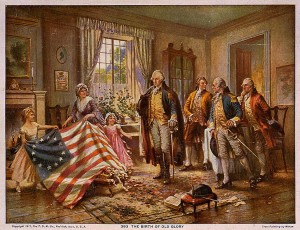What is Flag Day? It’s a great opportunity for students to explore Library of Congress primary sources and discover the history and meaning of an important national symbol: the flag of the United States. You may have some surprises in store for you.
On June 14, 1777, the Continental Congress approved the design of a national flag:
Resolved, That the flag of the ∥thirteen∥ United States be thirteen stripes, alternate red and white: that the union be thirteen stars, white in a blue field, representing a new constellation.
By 1916, when President Woodrow Wilson designated Flag Day a national holiday, the U.S. had expanded to 48 states. Try one or more of the following activities to help your students discover the history and symbolism of the Stars and Stripes as they learn how the flag changed over time.
Have your students:
- Speculate about how artists were selected to redesign the flag when new states joined the nation and list desirable skills or qualities. Read a story about the person who designed the current flag, and then review the list. Ask them how their thinking has changed.
- Analyze the Great Flag Day Puzzle that appeared in a 1916 Chicago newspaper. Why do they think this article was created and published? What more do they want to know?
- Imagine if Washington, D.C., were to obtain statehood. Design a flag that would include this new state.
- Count the stars and stripes in the 1777 flag in The Birth of Old Glory and discuss what they symbolize. Speculate about what the flag looked like after the 14th and 15th states, Vermont and Kentucky, were added. Were there more stars? More stripes? Something else? Check out Grand Old Flag to find out what happened, and compare with their speculations. How would the flag look today if each star represented one of the original colonies, and each stripe represented a state?
Additional Resources:
- Historical background for younger students: Flag Day Celebrated
- Historical background for secondary students: Flag Day
- Primary Source Set: Symbols of the United States
- Elementary learning activity: Stars, Stripes and Symbols of America: Comparing Our Flag, Past and Present
You can extend any of the above activities by using the Primary Source Analysis Tool and Teacher’s Guides to examine these primary sources further.
We’d love to hear if you or your students’ thinking about the U.S. flag changes after exploring these resources. Did anything surprise you?


